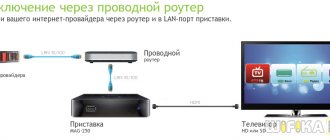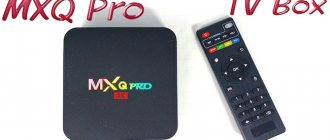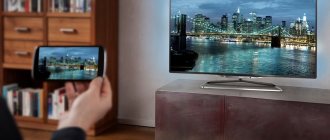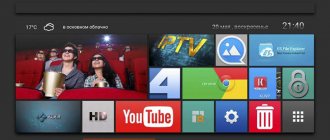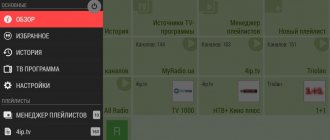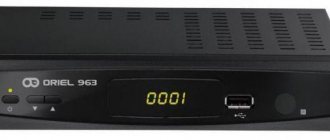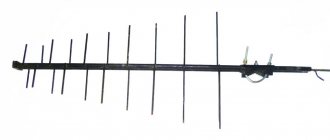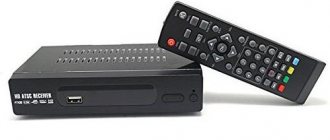The essence of the new technology is the transmission of digital television signals to computer IP networks. To do this, the signal is encrypted in a special way and transmitted to the playback device, which can be either a home computer or a special device - an iptv set-top box - the so-called STB or IP Set-Top-Box. On the computer, special iptv players decrypt the signal and display the image. For this purpose, the set-top box uses electronic decoder circuits that convert the encoded digital signal into analog video for the TV.
The main advantage of the technology is that it makes available a variety of digital resources, such as IP television or IP telephony.
The related principle of operation of these technologies guarantees reliable transmission of telephone or television signals through the now common fiber optic cable. At the same time, the quality of the transmission is such that it allows you to watch programs in very high resolution, with excellent color rendition and multi-channel sound. Another advantage of technology is its interactivity. An IP connection works in both directions: from client to server and back. Therefore, the consumer is able to control the service directly from a computer or set-top box.
Description of the console
Mag 250 IPTV Settopbox does not differ in appearance from similar devices - a black box with connectors for connecting to a TV located on the back side. USB is available at the front.
The device runs on the Linux 2.6 platform. Video streaming and IPTV connection available.
At the back, the set-top box has connectors: stereo A/V output, S/PDIF audio output, HDMI 1.3 and Ethernet 100 Mbit/s. There is also another USB connector here.
Available audio formats: WAV, MP3, M4A.
Supported audio codecs: MPEG-1, MPEG-2, MP3.
Video formats: MOV, MKV, AVI, MP4, QT.
Supported video codecs: MPEG1/2, H.264, MPEG4, XviD.
Image formats: GIF, JPEG, PNG, BMP.
The package includes an instruction manual, a tulip cable, a unit for connecting to the network, a remote control and batteries for it. You will also need to purchase an HDMI cable if your TV supports such a connection.
Connecting the set-top box
IPTV set-top box Mag 250 Micro is connected to the TV as follows:
- Do not connect the power supply of the set-top box until installation is complete.
- Connect the device to the TV using an available cable. If your TV supports HDMI, then use it for high picture quality. When connecting using tulips, connect the plugs and sockets in accordance with the color.
- Insert the cord for the Internet connection into the LAN connector of the previously installed router, connect the other end to the port of the set-top box.
- Connect the power supply to the outlet and device, turn on the TV.
To watch TV channels this is not enough; configuration is required.
Terrestrial digital television receiver K3 HD DVB-T2
«The Ministry of Telecom and Mass Communications delayed the transition to digital television for two weeks
“- such messages appeared today on news sites.
It is expected that from January 14-15, 2021, Russia will completely switch to digital broadcasting, and terrestrial analogue television will be turned off. Deputy Minister A. Volin emphasized that Russians who use analog TV should think in a timely manner about purchasing new televisions or set-top boxes in connection with the transition to digital television broadcasting, since in cities with a population of less than 100 thousand people it will be produced simultaneously
. On the very eve of the new year 2021, a full-scale broadcast in the DVB-T2 standard was launched in our region from all objects of the digital terrestrial television network. In this regard, a receiver (digital set-top box, tuner, set top box) K3 HD DVB-T2 was purchased. This device receives and converts digital television signals and has a number of convenient additional functions.
But, before going directly to the story about the purchase, I will try to answer questions that have not yet been asked.
Firstly, why do we need terrestrial digital television at all (in the form in which it exists now)?
Let's not discuss the qualitative (content) aspect of television, but consider only the quantitative one. Indeed, today only the RTRS-1 package (aka the first multiplex) consisting of 10 all-Russian mandatory public TV channels and 3 radio channels is available everywhere. Broadcasting of the RTRS-2 package (the second multiplex), containing the same number of channels, is now carried out only from four of almost seventy repeaters; expansion is expected only at the very end of 2021. There is not even talk about launching a third multiplex.
However, for the city this issue is not relevant until the New Year: the main channels are easy and simple to catch with an indoor or outdoor antenna. The standard package of a cable television operator (obviously it will continue to operate) is about 50 analogue channels in excellent quality, plus 20 digital channels in an additional package. Internet providers offer a wide variety of IPTV packages both in volume and price - more than 200 channels in total (terrestrial channel packages are free). In addition, the main advantage of the above types of television broadcasting over digital terrestrial broadcasting is that they broadcast all local television channels (up-to-date information about what is happening in the city is important!). According to the deputy minister, “ as for regional companies, they will all make decisions for themselves independently and can broadcast in analogue as long as they have the money and desire to do so.”
».
But outside the city, terrestrial digital television is already more than relevant. Here, good reception of an on-air television signal is hampered by complex mountainous terrain with significant elevation differences, long distances to repeaters and radio interference. Mobile Internet is unstable, there is no wired Internet.
Secondly, why buy a separate set-top box if DVB-T2 decoders are already built into all modern TVs?
Yes, this is true, but there are still a lot of old TVs in use that can work for decades without losing their performance and functionality. In addition, during the leapfrog with the choice of digital broadcasting format, a significant number of televisions were sold with “European” decoders, the DVB-T standard originally used in our country, which, as we know, is completely incompatible with the current DVB-T2. And apartments have long since had more than one TV, plus in a country house, in a country house - it’s unlikely that all of them will be of the latest generation.
Thirdly, why buy a receiver in China if there are plenty of them for sale offline?
Indeed, DVB-T2 receivers are widely available in electronics and household appliance stores at approximately the same prices. In principle, the choice of where to buy is, so to speak, a matter of taste and your preferences. Of course, I don't insist.
Now – about the actual purchase. The receiver is supplied in full retail packaging - a cardboard box measuring 19.5 x 16.5 x 5.0 cm with full-color printing. Inside there is a cardboard insert-partition that allows you to place and securely fix the included receiver and accessories. The box shows the main technical characteristics of the product:
The seller carefully wrapped the box on all sides with shock-absorbing material, so during the shipping process neither the box nor its contents were damaged at all.
Package Included:
1. Receiver. It is a small, compact and lightweight plastic box (size 12.5 x 9.0 x 3.0 cm, weight 173 g) black.
There are many ventilation holes on the top and bottom panels of the case. When choosing a future purchase, I noticed the frequent mention in reviews of similar receivers of their strong heating during operation. Therefore, I settled on a model with the largest number of ventilation holes and their location on the upper and lower edges of the case - for better convection. Whether this helps or not, I don’t know. During operation, the housing heats up to 44-45°C.
There is also a small LED on the top panel (it glows green in operating mode, and red in sleep mode).
On the front end there is a segment indicator in the center (device on/off is displayed as On/OFF, channel number - for example, C001, playback from external media - Usb). At the bottom left are physical buttons for turning on/off POWER and switching channels CH- and CH+). The preference for this particular model was made, among other things, because of the presence of these buttons: in the event of a malfunction or loss of the remote control, the device can still be used - this is convenient.
At the rear end there are antenna input connectors for a coaxial cable, a USB input, an HDMI output, as well as RCA composite output connectors. It should be noted that the connectors are well spaced, so cables and flash drives do not interfere with each other, connecting and disconnecting them is easy and simple.
Built-in power supply, 100-250 V, 50/60 Hz, power cord with Euro plug (no adapter needed), long enough (1 m). In operating mode, power consumption is 4.7-5.3 W, in standby mode – 0.6 W.
2. Remote control.
Simple and convenient. The size is proportional (4.5 x 2.1 x 15.1 cm). The shape is ergonomic and fits comfortably in the hand. Powered by two batteries (not included).
3. Composite audio video cable. The length is 94 cm, the quality of workmanship and the expected reliability are very average, but it copes with its tasks. By the way, there is no HDMI cable included. But this, I think, is not a problem: there is probably such a cable in the household.
4. Instructions.
The connection is easy: you need to connect the antenna cable to the ANT IN connector of the receiver, and the HDMI or RCA cable to the corresponding connectors of the receiver and TV.
Setup is simple and intuitive. At the initial stage, you need to select a language (Russification, by the way, is quite good), a country and start an automatic search for channels.
Ready!
The onscreen menu is also easy to use.
We are testing. In the first location (city, repeater almost in line of sight), an indoor telescopic antenna (folded) from some old TV was used as an antenna. However, in such greenhouse conditions it is generally possible to fish with a stripped section of coaxial cable, so this is not an indicator.
But in the second location, for which the receiver was actually purchased (countryside, difficult terrain, great distance from the repeater - almost on the border of the theoretical coverage area), everything is more serious: an external antenna with a signal amplifier, on a mast.
The image and sound are of high quality, as you would expect from digital television, and the reception is stable.
Among the additional functions of the receiver directly related to television broadcasting, I would like to especially note two - broadcast recording and Timeshift (delayed viewing). Using the first, you can record an excerpt of the broadcast onto an external drive connected to the USB 2.0 port of the receiver. For example, on a flash drive. .mts file parameters:
10 minutes of recording weighs 217 MB.
Subsequently, the file can be played both on the receiver itself and on any device with a video player, including a computer, smartphone, etc. However, you can only record the channel you are watching. The second function allows you to pause the broadcast and later resume watching from the moment you stopped it. During a pause, image and sound are also recorded to external media connected to the USB port (the buffer size can be edited in the menu). Timeshift.ts file parameters:
In addition, of course, there is teletext and an annotated program guide (TV guide).
Among the functions not directly related to television, we can note the built-in media player: audio, photo, video, as well as playback of your own broadcast recordings. Unfortunately, the media player is not omnivorous: for example, it does not play .mkv, nor does it play AC3 audio. Video resolutions greater than FullHD also do not play, however, this should not be expected. The problem, of course, is easily solved by converting the files.
In general, the K3 is a simple and convenient DVB-T2 terrestrial digital television receiver.
We are happy with the purchase.
Thank you for your attention!
Device setup
The setup is as follows:
- Take the remote control from the set-top box, press the “INPUT” button to select the source - HDMI or AV (tulips). If your TV has more than one HDMI connector, you must correctly indicate the number used.
- Once the download is complete, click on the “Setup” button.
- Open the “Settings” tab and click on “System Settings”.
- Go to the “Servers” section, where select “Portals”.
- In the "Portal 1 URL" line, enter the provider's URL. In the “Portal name” column, write the name of the prefix “mag”, click on the “Save” button.
- In the main menu, find the “Device Information” section and go to it. Manually write the MAC address of the device, which is indicated in the documents or at the bottom of the set-top box.
- Open the “Advanced Settings” tab, set the appropriate language and in the “Input Buffer Size” line write 1000.
- Launch the “Video Settings” section, where you change two parameters: “Video output mode” and “Graphics expansion” in accordance with the technical capabilities of the TV.
- Click "OK" button, restart the device.
At this point, the IPTV MAG 250 set-top box, the setup of which has been completed, is ready to receive a television broadcast signal from the provider.
Comparison
The main argument that manufacturers of the first type of device use in favor of their concept is flexibility. They say that with this operating scheme, the operator has the opportunity to update the software at any time, completely change the IPTV Middleware and, in general, perform any necessary manipulations.
Actually this is not true. More precisely, exactly the same, but it also applies to devices that can turn on independently. For all these devices, there are also service systems that include tools that provide broadcasting of the necessary software and utilities that allow you to “pull” any specific device or STB group and either simply “reboot” them, or update the software, or do something else. That is, the management and administration capabilities of the STB in no way suffer from whether it is loaded from the network every time it is turned on or only when initialized in the operator’s network.
Why are these differences important? There are two reasons:
- Firstly, in the conditions of Russian cities, where power surges are not an exceptional rarity, the fact that every time the power supply is interrupted, the interruption in service to the subscriber is at least a minute and a half, annoying.
- Secondly, be careful. For some reason, it often turns out that you have to pay extra for the need to load the set-top box every time you turn it on. Thus, one well-known manufacturer not only sells the broadcast server itself for more than 700 euros, but also licenses each STB it serves for a certain amount of euros.
By the way, the same Kreatel will make new, not yet released versions of set-top boxes just flashable once, and then updated upon request.
Additional software
For ease of use of the console, it is required. This is a player that allows you to watch TV channels, listen to music and manage content from a connected device.
The IPTV set-top box MAG250 is controlled from the remote control and phone. For the second method, install the application on your phone.




